(05)第5章 概率与概率分布
- 格式:ppt
- 大小:703.50 KB
- 文档页数:70
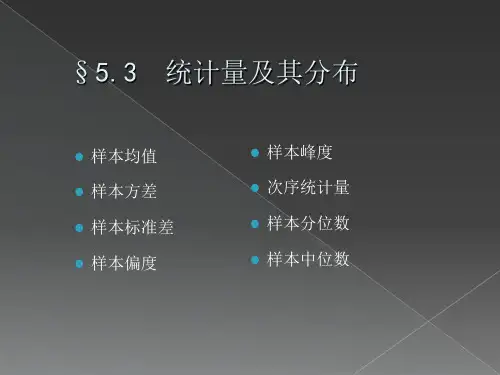
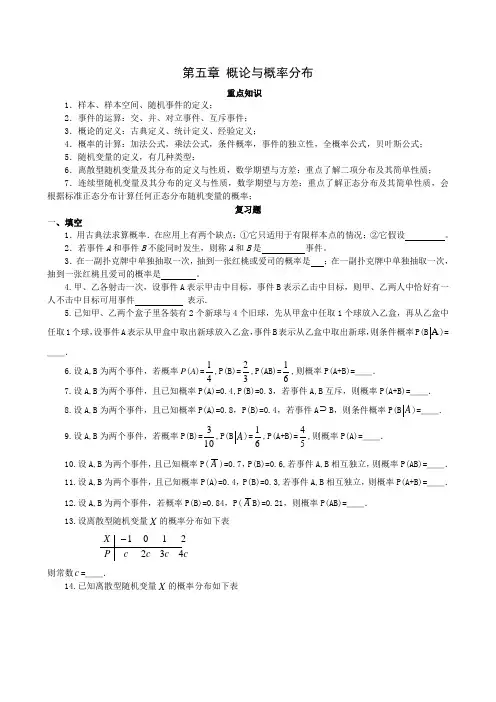
第五章 概论与概率分布重点知识1.样本、样本空间、随机事件的定义;2.事件的运算:交、并、对立事件、互斥事件;3.概论的定义:古典定义、统计定义、经验定义;4.概率的计算:加法公式,乘法公式,条件概率,事件的独立性,全概率公式,贝叶斯公式; 5.随机变量的定义,有几种类型;6.离散型随机变量及其分布的定义与性质,数学期望与方差:重点了解二项分布及其简单性质; 7.连续型随机变量及其分布的定义与性质,数学期望与方差:重点了解正态分布及其简单性质,会根据标准正态分布计算任何正态分布随机变量的概率;复习题一、填空1.用古典法求算概率.在应用上有两个缺点:①它只适用于有限样本点的情况;②它假设 。
2.若事件A 和事件B 不能同时发生,则称A 和B 是 事件。
3.在一副扑克牌中单独抽取一次,抽到一张红桃或爱司的概率是 ;在一副扑克牌中单独抽取一次,抽到一张红桃且爱司的概率是 。
4.甲、乙各射击一次,设事件A 表示甲击中目标,事件B 表示乙击中目标,则甲、乙两人中恰好有一人不击中目标可用事件 表示.5.已知甲、乙两个盒子里各装有2个新球与4个旧球,先从甲盒中任取1个球放入乙盒,再从乙盒中任取1个球,设事件A 表示从甲盒中取出新球放入乙盒,事件B 表示从乙盒中取出新球,则条件概率P(B A )=__.6.设A,B 为两个事件,若概率P (A )=41,P(B)=32,P(AB)=61,则概率P(A+B)=__.7.设A,B 为两个事件,且已知概率P(A)=0.4,P(B)=0.3,若事件A,B 互斥,则概率P(A+B)=__. 8.设A,B 为两个事件,且已知概率P(A)=0.8,P(B)=0.4,若事件A ⊃B ,则条件概率P(B A )=__. 9.设A,B 为两个事件,若概率P(B)=103,P(B A )=61,P(A+B)=54,则概率P(A)=__.10.设A,B 为两个事件,且已知概率P(A )=0.7,P(B)=0.6,若事件A,B 相互独立,则概率P(AB)=__. 11.设A,B 为两个事件,且已知概率P(A)=0.4,P(B)=0.3,若事件A,B 相互独立,则概率P(A+B)=__. 12.设A,B 为两个事件,若概率P(B)=0.84,P(A B)=0.21,则概率P(AB)=__. 13.设离散型随机变量X 的概率分布如下表ccccPX 4322101-则常数c =__.14.已知离散型随机变量X 的概率分布如下表414121P321X则概率P {3<X }=__.15.已知离散型随机变量X 的概率分布如下表6632P213-X11则数学期望)(X E =__.16.设离散型随机变量X 服从参数为p 的两点分布,若离散型随机变量X 取1的概率p 为它取0的概率q 的3倍,则方差)(X D =__.17.设连续型随机变量的概率X 密度为⎪⎩⎪⎨⎧<<-=其他,0210,1)(2x x k x ϕ 则常数k =__.18.设连续型随机变量X 的概率密度为⎩⎨⎧≤≤=其他,00,24)(2rx x x ϕ 则常数r =__.19.已知连续型随机变量X 的概率密度为⎪⎩⎪⎨⎧≥=-其他,00,2)(2x xex xϕ 则概率}11{<<-X P =__.20.已知连续型随机变量X 的概率密度为⎪⎩⎪⎨⎧≤≤=其他,021,2)(2x x x ϕ 则数学期望)(X E =_____.21.设X 为随机变量,若数学期望1)12(=-X E ,则数学期望)(X E =__.22.设X 为随机变量,若方差3)63(=-X D ,则方差)(X D =__.二、单项选择1.设A,B 为两个事件,若事件A ⊃B ,则下列结论中( )恒成立.(a)事件A,B 互斥 (b)事件A,B 互斥 (c)事件A ,B 互斥 (d)事件A ,B 互斥 2.设A,B 为两个事件,则事件B A +=( ).(a)A +B (b)A-B (c)A B (d)AB3.投掷两颗均匀骰子,则出现点数之和等于6的概率为( ).(a)111 (b)115 (c)361 (d)3654.盒子里装有10个木质球与6个玻璃球,木质球中有3个红球、7个黄球,玻璃球中有2个红球、4个黄球,从盒子里任取1个球.设事件A 表示取到玻璃球,事件B 表示取到红球,则条件概率P(A B )=( ).(a)114 (b)74 (c)83 (d)535.设A,B 为两个事件,若概率P(A)=31,P(A B )=32,P(A B )=53,则概率P(B)=__.(a)51 (b)52 (c)53 (d)546.设A,B 为两个事件,且已知概率P(A)>O ,P(B)>0,若事件A ⊃B,下列等式中( )恒成立.(a)P(A+B)=P(A)+P(B) (b)P(A-B)=P(A)-P(B)(c)P(AB)=P(A)P(B) (d)P(B A )=17.设A,B 为两个事件,则概率P(A+B)=( ).(a)P(A)+P(B) (b)P(A)+P(B)-P(A)P(B)(c)1-P (B A ) (d)1-P( A )P(B ) 8.设A,B 为两个事件,若概率P(A)=31,P(B)=41,P(AB)=121,则( ).(a)事件A 包含B (b)事件A ,B 互斥但不对立 (c)事件A ,B 对立 (d)事件A ,B 相互独立 9.设A,B 为两个事件,且已知概率P(A)=53,P(A+B)=107,若事件A,B 相互独立,则概率P(B)=( ).(a)161 (b)101 (c)41 (d)5210.设A,B 为两个事件,且已知概率P(A)>O ,P(B)>O ,若事件A,B 相互独立,则下列等式中( )恒成立.(a)P(A+B)=P(A)+P(B) (b)P(A+B)=P(A) (c)P(A-B)=P(A)-P(B) (d)P(A-B)=P(A)P(B )11.中( )可以作为离散型随机变量X 的概率分布.(a)6321-P321X11 (b)653-21P321X1(c)6321P321X 11 (d)65321P321X 112.已知离散型随机变量X 的概率分布如下表52511015110142101PX-则下列概率计算结果中( )正确.(a)0}3{==X P (b)0}0{==X P . (c)1}1{=->X P (d)1}4{=<X P13.设离散型随机变量X 的所有可能取值为-1与l ,且已知离散型随机变良X 取-1的概率为)10(<<p p ,取1的概率为q ,则数学期望=)(2X E ( ).(a)O (b)l (c)p q - (d)2)(p q - 14.设连续型随机变量X 的概率密度为⎪⎩⎪⎨⎧≥+=其他,00,1)(2x x kx ϕ 则常数k =( ).(a)π1(b)π (c)π2(d)2π15.下列函数中( )不能作为连续型随机变量X 的概率密度.(a)⎩⎨⎧≤≤-=其他,001,3)(2x x x f (b)⎪⎩⎪⎨⎧≤≤-=其他,021,2)(x x x g(c)⎪⎩⎪⎨⎧≤≤=其他,020,cos )(πx x x h (d)⎪⎩⎪⎨⎧≤≤=其他,02,sin )(ππx x x h 16.设X 为连续型随机变量,若b a ,皆为常数,则下列等式中( )非恒成立.(a)}{}{a X P a X P ==≥ (b)}{}{b X P b X P <=≤ (c)1}{=≠a X P (d)0}{==b X P 17.已知连续型随机变量X 的概率密度为⎪⎩⎪⎨⎧<<=其他,040,81)(x x x ϕ 则数学期望)(X E =( ).(a)21 (b)2 (c)83 (d)3818.设X 为随机变量,若数学期望)(X E 存在,则数学期望))((X E E =( ).(a)O (b))(X E (c))(2X E (d)2))((X E 19.设X 为随机变量,若方差)(X D =4,则方差)43(+X D =( ).(a)12 (b)16 (c)36 (d)4020.设X ,Y 为随机变量,已知随机变量X 的标准差等于4,随机变量Y 的标准差等于3,若随机变量X ,Y 相互独立,则随机变量X -Y 的标准差等于( ).(a)1 (b)7 (c)5 (d)7四、名词解释1、 数学期望:2、 对立事件:3、 随机事件:4、 事件和:5、 事件积:6、 互斥事件:7、 互相独立事件:五、判断题1.对于连续型随机变量,讨论某一点取值的概率是没有意义的。
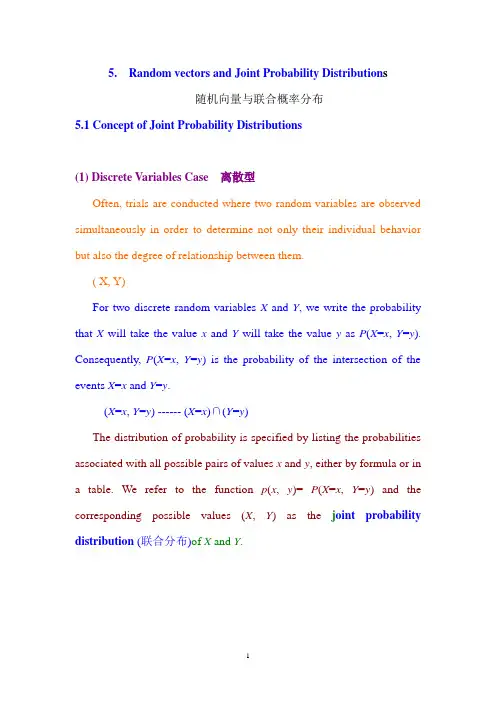
5. Random vectors and Joint Probability Distribution s随机向量与联合概率分布5.1 Concept of Joint Probability Distributions(1) Discrete Variables Case 离散型Often, trials are conducted where two random variables are observed simultaneously in order to determine not only their individual behavior but also the degree of relationship between them.( X, Y)For two discrete random variables X and Y, we write the probability that X will take the value x and Y will take the value y as P(X=x, Y=y). Consequently, P(X=x, Y=y) is the probability of the intersection of the events X=x and Y=y.(X=x, Y=y) ------ (X=x)∩(Y=y)The distribution of probability is specified by listing the probabilities associated with all possible pairs of values x and y, either by formula or in a table. We refer to the function p(x, y)=P(X=x, Y=y) and the corresponding possible values (X, Y) as the j oint probability distribution (联合分布)of X and Y.They satisfy(,)0, (,)1xyp x y p x y ≥=∑∑,where the sum is over all possible values of the variable.Example 5.1.1 Calculating probabilities from a discrete joint probability distributionLet X and Y have the joint probability distribution.(a) Find (1)P X Y +>;(b) Find the probability distribution ()()X p x P X x == of the individualrandom variable X . Solution(a) The event 1X Y +>is composed of the pairs of values (l,1), (2,0), and (2,l). Adding their corresponding probabilities(1)(1,1)(2,0)(2,1)0.20.100.3.P X Y p p p +>=++=++=(b) Since the event X =0 is composed of the two pairs of values (0,0) and (0,1), we add their corresponding probabilities to obtain(0)(0,0)(0,1)0.10.20.3P X p p ==+=+=.Continuing, we obtain (1)(1,0)(1,1)0.40.20.6P X p p ==+=+= and(2)(2,0)(2,1)0.100.1P X p p ==+=+=.In summary, (0)0.3X p =, (1)0.6X p = and (2)0.1X p =is the probabilitydistribution of X . Note that the probability distribution ()X p x of appears in the lower margin of this enlarged table. The probability distribution ()Y p y of Y appears in the right-hand margin of the table. Consequently, the individual distributions are called marginal probability distributions .(边缘分布)From the example, we see that for each fixed value of x , the marginalprobability distribution is obtained as()()(,)X yP X x p x p x y ===∑,where the sum is over all possible values of the second variable. Continuing, we obtain()()(,)Y xP Y y p y p x y ===∑.Example 3.5.3Suppose the number X of patent applications (专利申请)submitted by a company during a 1-year period is a random variable having thePoisson distribution with mean λ, (()!n e P X n n λλ-==)and the variousapplications independently have probability (0,1)p ∈ of eventually being approved.Determine the distribution of the number of patent applications during the 1-year period that are eventually approved.先求联合分布密度,再求边缘分布Solution Let Y be the number of patent application being eventually approved during 1-year period. Then the event {}Y k = is the union of mutually exclusive events {,}X n Y k == ()n k ≥.If X n =, then the random variable S has the binomial distribution with parameter n and p :(|)(1)k k n k n P Y k X n C p p -===-. (0)n k ≥≥ Thus(,)()(|)P X n Y k P X n P Y k X n ====== (1)!nk kn k n e C p p n λλ--=⋅⋅-when k>n, P(X=n, Y=k)=0,Hence the distribution of Y is()(,)(,)n n kP Y k P X n Y k P X n Y k ∞∞=========∑∑(1)!nk kn k n n ke C p p n λλ∞--==⋅⋅-∑!(1)!!()!nk n k n k n e p p n k n k λλ∞--==⋅⋅--∑(1)!()!kn kkn k n ke p p k n k λλλ-∞--==⋅⋅--∑()(1)(1)()()!!!mk k p m p p p e e ek m k λλλλλλ∞---=-==∑ ()!k pp e k λλ-= Thus, Y has the Poisson distribution of mean p λ. exercise从1,2,3,4,5五个数中不放回随机的接连地取3个,然后按大小排成123X X X <<,试求13(,)X X 的联合分布,x1,x3 独立吗?Homework Chap 5 1,(2) Continuous Variables Case 连续型随机向量There are many situations in which we describe an outcome by giving the values of several continuous random variables. For instance, we may measure the weight and the hardness of a rock, the pressure and the temperature of a gas. Suppose that X and Y are two continuous random variables. A function (,)f x y is called the joint probability density of these random variables, if the probability that , a X b c Y d ≤≤≤≤ is given by the multiple integral(, )(,)b da cP a X b c Y d f x y dxdy ≤≤≤≤=⎰⎰Thus, a function (,)f x y can serve as a joint probability density if all of the following hold:for all values of x and y , f is integrable on R 2 andTo extend the concept of a cumulative distribution function to the two variables case, we can define F (x , y )(, )(, )F x y P X x Y y =≤≤,and we refer to the corresponding function F as the joint cumulative distribution function of the two random variables.Example 5.1.2If the joint probability density of two random variables is given by236 for 0,0(,)0 elsewherex y e x y f x y --⎧>>=⎨⎩ Find the joint distribution function, and use it to find the probability(2,4)P X Y ≤≤.Solution By definition,23006 for 0, 0(,)(,)0 elsewhere y x yu vxe du e dv x y F x yf u v dudv ---∞-∞⎧>>⎪==⎨⎪⎩⎰⎰⎰⎰Thus,23(1)(1) for >0, >0(,)0 elsewhere x y e e x y F x y --⎧--=⎨⎩.Hence,412(2, 4)(2, 4)(1)(1)0.9817P X Y F e e --≤≤==--=.ExampleIf the joint probability density of two random variables is given by2,1,01(,)0,kxy x y x f x y ⎧≤≤≤≤=⎨⎩其他(a)find the k; (b)find the probability2((,)),{(,)|,01}P X Y D D x y x y x x ∈=≤≤≤≤solutionsince(,)1f x y dxdy ∞∞-∞-∞=⎰⎰24111001(,)()226x x kf x y dxdy dx kxydy k x dx ∞∞-∞-∞==-=⎰⎰⎰⎰⎰ hence k=6.21124001((,))663()4xx DP X Y D xydxdy dx xydy x x x dx ∈===-=⎰⎰⎰⎰⎰joint marginal densities 边缘密度Given the joint probability density of two random variables, the probability density of the X or Y can be obtained by integrating out another variable,The functions f X and f Y respectively are called the marginal density (边缘密度)of X and Y .,ExampleThe joint probability density of two random variables is given by26,1,01(,)0,xy x y x f x y ⎧≤≤≤≤=⎨⎩其他find the marginal density from the joint density when [0,1]x ∈,215()(,)633X xf x f x v dv xydy x x +∞-∞====-⎰⎰[0,1]x ∉,()0X f x =,hence 533,01()0,X x x x f x elsewhere ⎧-≤≤=⎨⎩23,01()0,Y y y f x elsewhere ⎧≤≤=⎨⎩exercises求服从B 上均匀分布的随机向量(X,Y )的分布密度及分布函数。




第五章 概率、概率分布与临床决策练 习 题一、最佳选择题1.若事件A 和事件B 互不相容,则一定有( )。
A. P (A +B )=P (A )+P (B )B. P (A +B )=P (AB )C. P (AB )= P (A ) P (B )D. P (A │B )= P (A )E. P (B │A )= P (B )2.若人群中某疾病发生的阳性数X 服从二项分布,则从该人群随机抽取n 个人,阳性数X 不小于k 人的概率为( )。
A. P (k )+ P (k +1)+…+ P (n )B. P (k +1)+ P (k +2)+…+ P (n )C. P (0)+ P (1)+…+ P (k )D. P (0)+ P (1)+…+ P (k -1)E. P (1)+ P (2)+…+ P (k -1)3.Poisson 分布的标准差σ和平均数λ的关系是( )。
A.λ=σ B. λ<σ C. λ=σ2 D. λ= E. λ>σ4.当n 很大,二项分布在下列条件下可用Poisson 分布近似( )。
A. λπ≈nB. λ≈n X /C. λππ≈-)1(nD. λππ≈-)1(E. λππ≈-n /)1(5.对于任何两个随机变量X1和X2,一定有( )。
A. E (X 1+X 2)=E (X 1)+E (X 2)B. V (X 1+X 2)=V (X 1)+ V (X 2)C. E (X 1+X 2)=E (X 1)·E (X 2)D. V (X 1+X 2)=V (X 1)·V (X 2)E. E (X 1+X 2)=E (X 1X 2)二、问答题1.简述概率的统计定义。
2.举例说明医学观察结果中的离散型随机变量和连续型随机变量。
3.举例说明医学现象中的先验概率和后验概率。
4.简述二项分布的应用条件。
5.简述Poisson 分布的性质特征。
6.简述概率和概率分布在临床决策中的运用。
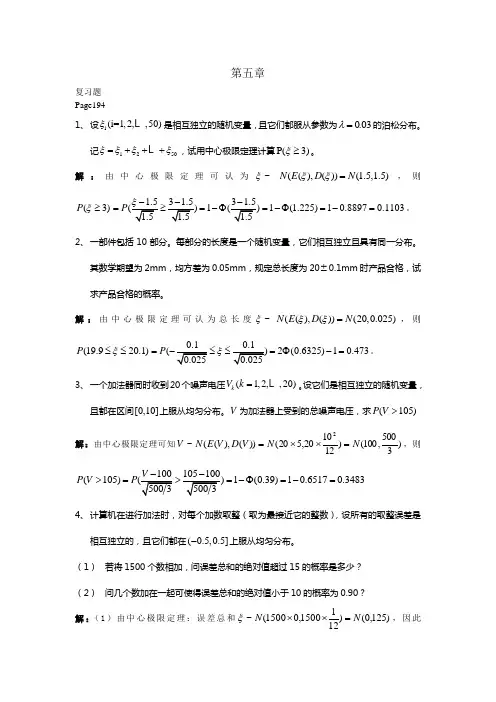
第五章复习题Page1941、 设i (i=1,2,,50)ξ 是相互独立的随机变量,且它们都服从参数为0.03λ=的泊松分布。
记1250ξξξξ=+++ ,试用中心极限定理计算P(3)ξ≥。
解:由中心极限定理可认为~ξ((),())(1.5,1.5)N E D N ξξ=,则(3)P ξ≥1.31.5)1)1(1.225)10.889751.51.5P ===-Φ=-=。
2、 一部件包括10部分。
每部分的长度是一个随机变量,它们相互独立且具有同一分布。
其数学期望为2mm ,均方差为0.05mm ,规定总长度为20±0.1mm 时产品合格,试求产品合格的概率。
解:由中心极限定理可认为总长度~ξ((),())(20,0.025)N E D N ξξ=,则(19.920.P ξ≤≤()2(0.6325)10.4735025P ξ=≤=Φ-=。
3、 一个加法器同时收到20个噪声电压(1,2,,20)k V k = 。
设它们是相互独立的随机变量,且都在区间[0,10]上服从均匀分布。
V 为加法器上受到的总噪声电压,求(105)P V >解:由中心极限定理可知)3500,100()121020,520())(),((~2N N V D V E N V =⨯⨯=,则(105))1(0.39)10.65170.3483P V P >=>=-Φ=-= 4、 计算机在进行加法时,对每个加数取整(取为最接近它的整数),设所有的取整误差是相互独立的,且它们都在(0.5,0.5]-上服从均匀分布。
(1) 若将1500个数相加,问误差总和的绝对值超过15的概率是多少?(2) 问几个数加在一起可使得误差总和的绝对值小于10的概率为0.90?解:(1)由中心极限定理:误差总和)125,0()1211500,01500(~N N =⨯⨯ξ,因此(||15)2(12(10.9099)0.1802P P ξ>=>=-Φ=⋅-=。

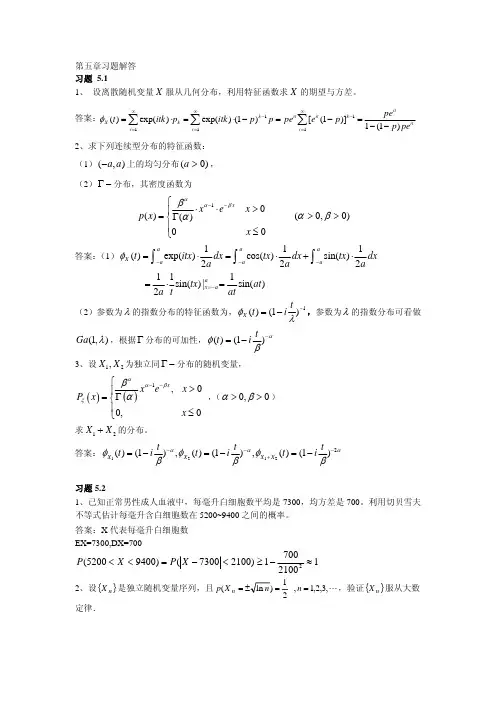
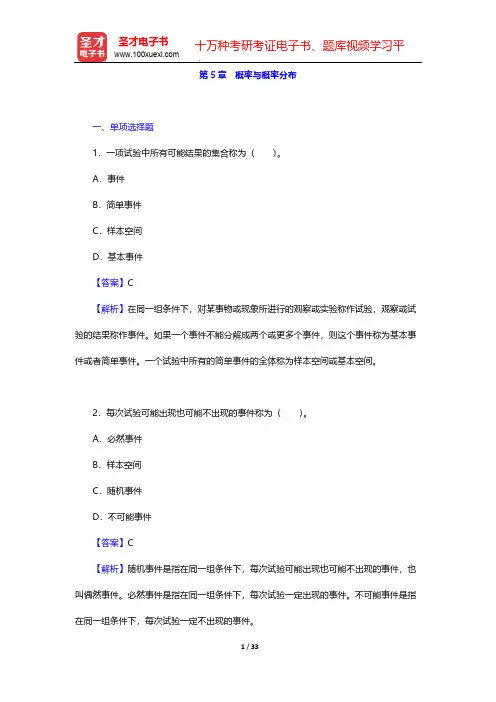
第 ×× 次课 2学时本次课教学重点:常用的统计量 本次课教学难点:总体,简单随机样本,统计量的概念。
本次课教学内容:第五章 数理统计的基础知识 第一节 数理统计的基本概念 教学组织: 一、引言在前五章中我们学习了概率论的基本内容,因为随机变量及其所伴随的概率分布全面描述了随机现象的统计规律性,所以在概率论的许多问题中,概率分布通常都是已知的,或者假设是已知的,而一切计算与推理都是在此基础上得出来的。
然而,实际情况往往并非如此。
一个随机现象所服从的分布概型可能完全不知道,或者只知道其概型而不知其分布函数中所含的参数。
例如,某工厂生产的灯泡的寿命服从什么分布是不知道的。
再如,某厂生产的一件产品是合格品还是不合格品,我们知道它服从两点分布,但其参数p 却不知道。
那么怎样才能知道一个随机现象的分布或其参数呢?这就是数理统计所要解决的一个首要问题。
为了获得灯泡的寿命分布,我们从所有的灯泡中抽出一部分进行观察与测试以取得相关信息,从而做出推断。
由于观察和测试是随机现象,依据有限个观察与测试对整体所做出的推断不可能绝对准确,这个不确定性我们用概率来表达。
数理统计学的基本问题就是依据观测或试验所取得的有限信息对整体做出推断,每个推断必须伴有一定的概率来表明其可靠程度。
这种伴有一定概率的推断称为统计推断。
二、总体与随机样本 1、总体在数理统计中,我们往往研究有关对象的某一数量指标(如灯泡的寿命这一数量指标)。
为此,考虑与这一数量指标相联系的随机试验,对这一数量指标进行试验或观察。
我们把研究对象的全体所构成的一个集合称为总体,总体中的每个对象称为个体。
总体中所包含的个体的个数称为总体的容量。
容量有限的总体称为有限总体,容量无限的总体称为无限总体。
例如,考察某批灯泡的质量,如这一批灯泡共有5000只,每个灯泡的寿命是一个可能的观察值,是一个个体。
所有5000只灯泡的寿命是一个有限总体。